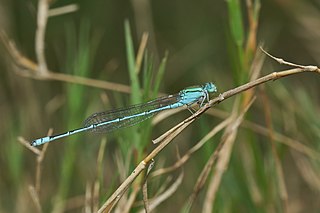
Azure is a bright, cyan-blue color that is often described as the color of the sky on a clear day.

Enallagma cyathigerum is a species found mainly between latitudes 40°N and 72°N. The species can reach a length of 32 to 35 mm. It is common in many different countries including Russia, Europe and South Korea. Damselflies are an important link between the health of the aquatic ecosystem and its response to climate change.

The variable damselfly or variable bluet is a European damselfly. Despite its name, it is not the only blue damselfly prone to variable patterning.

The Irish damselfly or crescent bluet is a damselfly found in northern Europe and Asia to north-eastern China;. It is common and widespread in northern Finland, scarce and local in the Netherlands and Ireland and rare elsewhere. One of its English name comes from the fact that it is found in Ireland but not in Britain. The alternative name, crescent bluet, refers to the shape of the markings on segment two of the male and its scientific name.

The azure damselfly is a species of damselfly found in most of Europe. It is notable for its distinctive black and blue colouring. They are commonly found around ponds and lakesides during the summer.

The River Glaven in the eastern English county of Norfolk is 10½ miles long and flows through picturesque North Norfolk countryside to the North Sea. Rising from a tiny headwater in Bodham the river starts 2½ miles before Selbrigg Pond where three streams combine at the outfall. The scenic value of the Glaven valley is important to the tourist industry in North Norfolk. The river is also 15km long and is one of over 200 chalk rivers in the world and one of 160 in the UK.

Coenagrion is a genus of damselflies in the family Coenagrionidae, commonly called the Eurasian Bluets. Species of Coenagrion are generally medium-sized, brightly coloured damselflies.

Lady's Wood is a 7.1 hectare nature reserve west of Upwood in Cambridgeshire. It is managed by the Wildlife Trust for Bedfordshire, Cambridgeshire and Northamptonshire.

Esme longistyla is damselfly in the family Platycnemididae. It is commonly known as the Nilgiri bambootail. It is endemic to Western Ghats in India.

Diphlebiidae is no longer recognised as a biological family. It was the name given to a small family of damselflies, the azure damselflies, with species in two genera: Diphlebia and Philoganga. Diphlebia is found in Australia and Philoganga is found in Southeast Asia. They are large and thick-bodied damselflies. They rest with their wings spread out. The Diphlebiidae were also known as Philogangidae.

Diphlebia is a genus of damselflies in the family Lestoideidae. They are commonly known as rockmasters. These damselflies are very large and thick. The species in this genus are found in Eastern Australia, except for one species that can be found in New Guinea. The males are vividly patterned. They are blue or bluish green and black in colour. Their blue colour also gives them the name azure damselflies. They rest with their wings spread out. Their wings are usually blackish brown or have white markings. These damselflies have several present antenodal crossveins. The two basal crossveins extend across costal and subcostal spaces. The larvae are wide and flat. They have long saccoid gills enabling them to breathe underwater. The inner tooth of their labial palps is elongated. The specific characters of the larva are mid-ventral, distal width, basal width, and length of median lobe.

Pseudagrion decorum, elegant sprite or three striped blue dart, is a species of damselfly in the family Coenagrionidae. It is found in many tropical Asian countries.

Englemere Pond is a 26.1-hectare (64-acre) biological Site of Special Scientific Interest on the southern outskirsts of North Ascot in Berkshire. The site is also a Local Nature Reserve. It is owned by the Crown Estate and managed by Bracknell Forest Borough Council.

Caconeura ramburi is a damselfly species in the family Platycnemididae. It is commonly known as the Coorg Bambootail or Indian blue bambootail. It is endemic to Western Ghats.

Caconeura risi is a damselfly species in the family Platycnemididae. It is endemic to Western Ghats.

Caconeura gomphoides is a damselfly species in the family Platycnemididae. It is endemic to high altitude peat bogs and grassy uplands in Nilgiris.

Indolestes davenporti is a species of damselfly in the family Lestidae. It is known only from Western Ghats, south of Palakkad Gap.

Enallagma aspersum, the azure bluet, is a species of narrow-winged damselfly in the family Coenagrionidae. It is found in North America.
This page is based on this
Wikipedia article Text is available under the
CC BY-SA 4.0 license; additional terms may apply.
Images, videos and audio are available under their respective licenses.
















